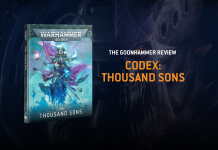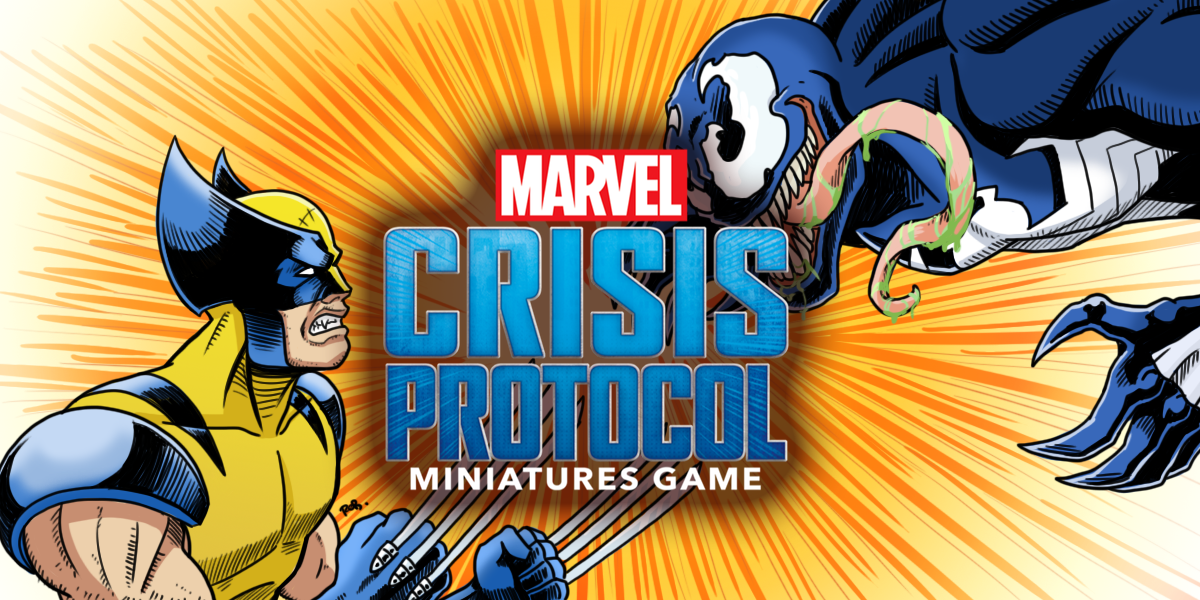Okay, True Believers, you’ve got your Marvel Crisis Protocol models all assembled and beautifully painted, you’ve marked off a 3’x3’ playing surface, you’re Scrooge McDucking in your piles of tokens, so you’re all set to play, right? WRONG! You need terrain, bucko! Not only for hiding behind like some kind of mewling craven but also to THROW AT YOUR ENEMIES!!!
One of the most awesome parts of comic books and superhero movies is all the property destruction. Right out of the gate you’ve got Superman on the cover of Action Comics #1 smashing up a car. You get kicked out of the Supervillains Union if you don’t blast a hero through a wall at least once a month. Some characters like the Hulk have truly raised collateral damage to an art form.
The terrain rules are probably the most common thing that new MCP players bounce off of. They’re different from a lot of other games, mainly in that they are very interactive and not just a hill you stand on to get a +1 bonus to attacks against insane former apprentices on lava planets or some such. And in particular the line of sight and cover rules as they relate to terrain are kind of funky to put it kindly.
What Terrain Do I Need and How Much?
The core rule book calls for “12 terrain features ranging from Size 1 to Size 5, with the majority of features being Sizes 2–4,” and a blog post from Atomic Mass suggests 12-20 pieces!

Size Matters
MCP classifies terrain into size values of 1 through 5. The lamp posts in the core set are Size 1, the cars Size 2, the Daily Bugle stand Size 3. The chemical truck/garbage truck is Size 4. Large buildings would be Size 5, and theoretically there could be larger sizes but they’d probably take up a lot of your board and you can’t really interact with them in any meaningful way. One of the best things about the official Atomic Mass terrain is that it has the Size value printed right on the bottom of the piece. For other terrain, talk with your opponent at the start of your game about what size each piece is.
Where Can I Get Terrain?
So you need a bunch of terrain. The good news is that if you picked up the MCP Core Set you have a bunch of it already – two streetlights, two lamp posts, two cars, two dumpsters, and a Daily Bugle newsstand. That’s a fairly decent spread but it’s not quite enough.
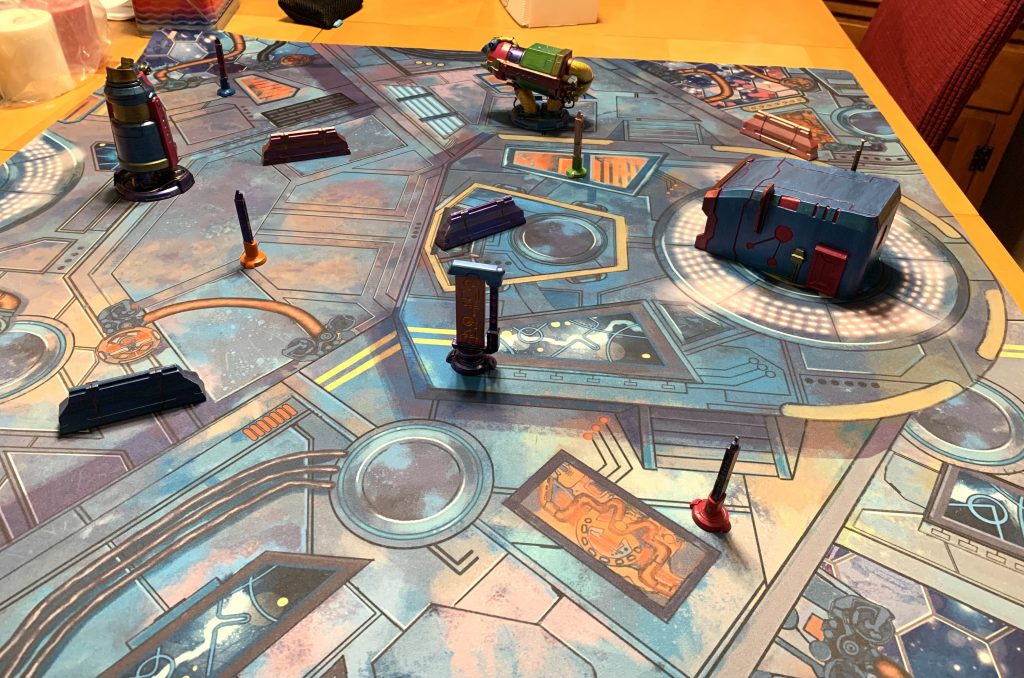
Fortunately, Atomic Mass Games is happy to sell you more terrain. They currently have a garbage truck/chemical truck box, a construction site box, a Kirby-esque cosmic set, and a box that has more of the stuff from the Core Set. Any one of these – except the truck, since that’s only one per box – plus the core set will get you more than enough for a solid table. The Cosmic set doesn’t exactly mesh aesthetically with the dumpsters and Daily Bugle shop, but you can just say Galactus plopped down some planet-eating gear in the middle of Park Avenue and call it a day.
I’m going out on a limb and guessing that if you read articles on Goonhammer dot com you may be interested in other miniatures games as well. Any terrain you have for other games will be fine although the scale may be a bit small compared to the larger MCP models. MCP runs around 1:45, a lot of “heroic 28mm” terrain is around 1:53 to 1:56 so not a huge amount of difference, and just pretend all the skulls and eagles are Latverian.
There are plenty of other sources of terrain too, especially if you’re sticking with a New York City theme (and considering how much of the comics takes place on NYC streets there’s nothing wrong with that). There’s a rack of die-cast metal cars and trucks at my grocery store that is just about the right scale, and they’re only a couple bucks each. A wander through the toy aisles of a department store or even a dollar store will probably yield some usable pieces. You can look at model railroad buildings – you’ll want O scale as that’s around the same 1:45 as MCP. Most of this has a somewhat dated “Americana” look though so it may not fit as well with modern-looking urban trappings.
Lastly, the world of 3D printing is lousy with all sizes and shapes of terrain. Get yourself a printer or a sucker friend who has a printer and your heroes
villains will never want for stuff to throw! Corvus Games Terrain in particular has a number of “Urban and Heroic” designs, many of which are familiar locations from the Marvel comics and movies. A lot of their terrain is designed for 28mm games, and they suggest scaling up to 110-125% for use with Marvel Crisis Protocol.
What Can I Do With Terrain?
Terrain size has a number of different effects in the game. Almost all the terrain in MCP is interactive, meaning it can be thrown around and destroyed. And yes, while you technically could hide behind some of it we don’t really encourage such behavior here in the GHMCP Bullpen. So terrain serves four purposes in an MCP game: 1) something to throw at characters, 2) something to throw characters into, 3) blocking line of sight, and 4) providing cover.
Throwing Things
Only certain characters can throw terrain – it’s usually a Superpower on their card or a Team Tactics card. The power or card will specify 1) how close you have to be to the terrain piece, 2) the maximum size it can be, and 3) how far you can throw it. Chucking a car or something means you lay out the appropriate movement tool in the direction you’re throwing the thing (starting from the character, not from where the terrain started, unless otherwise specified) and it collides with the first character or piece of terrain it contacts. It’s important to realize that even when throwing something large like the Daily Bugle newsstand, even though the model itself is fairly big and could conceivably clip more than one character, you only hit one target. Them’s the breaks, pal.
Other than it being cool, why would you want to throw terrain? Mainly because it causes damage. If the thrown piece collides with a character they have to make a Dodge roll using their Physical defense against damage of the object’s Size plus one, cancelling out a point of damage for each Block, Wild, or Crit rolled. In most cases no attack roll is needed, there’s just the dodge. The terrain piece is then considered destroyed and removed from the table. And that’s a second reason why you may want to throw terrain at someone – to keep them from hiding behind it.
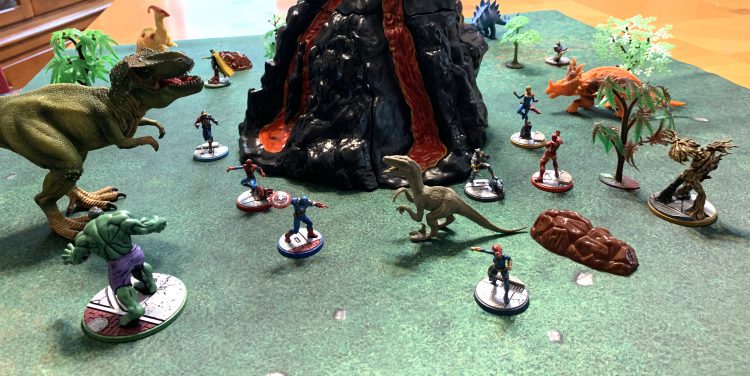
Throwing People At Things (or other people)
Most attacks and Superpowers that can throw terrain can also throw characters. If a thrown character comes in contact with either an object or another character, the thrown character takes a point of damage (no defense roll, just auto-damage). If the character was thrown into a piece of terrain and that terrain is smaller than the character the terrain is destroyed. If the character was thrown into another character, the collided-with character has to make a dodge roll or they too take damage. This is often helpful for dealing that one extra point of damage, or for getting past an enemy’s high defenses. Plus gets them out of position and disrupts your opponent’s carefully laid plans.
It’s important to remember that powers or attacks that Push a character do not cause collisions, even if the pushed character bumps into something.
Not Being Seen
If you want to avoid getting stomped by a giant green rage monster or blasted by, well, pretty much anybody, being behind something and out of sight is a good way to accomplish that goal. In MCP characters don’t block line of sight, but terrain can. Terrain blocks line of sight if it is larger than the target. If you can’t draw a line between any point on the attacker’s and target’s bases without crossing the terrain you don’t have line of sight. Can’t be seen, can’t be targeted. Usually. That’s fairly straightforward, right?
So what happens if a character is on top of a piece of terrain? In that case you add the character’s size and the terrain’s size together for determining line of sight to the character. If Spider-Man (size 2) is on top of a Size 5 building, that’s Size 7 and you can pretty much see him from anywhere on the board; there’s no terrain larger than Size 7 to block the view
Now, here’s where it gets weird, bub.
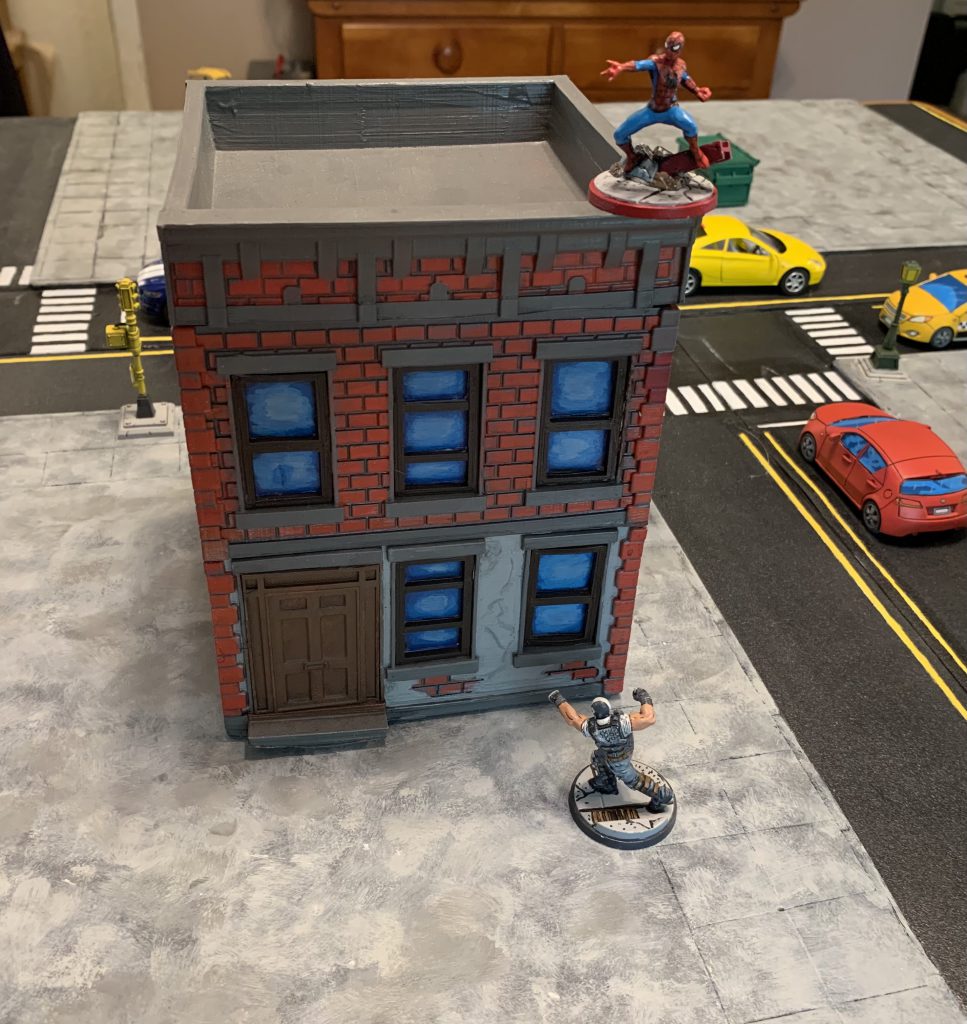
What if Spidey is back from the edge of the building an inch or two and the model is not even visible to Crossbones down on the ground? Crossbones still has line of sight to Spider-Man in this instance. LOS is checked as if the board were two dimensional so heights and angles don’t matter. There’s no crouching down and looking as if you were the attacking model. Measure horizontally to see if the target is within range of the attack regardless of elevation differences. It’s a fairly simple rule but to be honest I had a very hard time getting it through my head at the start, mainly because I was used to more complicated rulesets for determining LOS. As the little green guy says, you must unlearn what you have learned. And yes, it can lend itself to weird counterintuitive situations, like Crossbones on the ground punching Spider-Man five storeys up. Like all things in this or other games, it’s an abstraction and that’s just how MCP chooses to handle it.
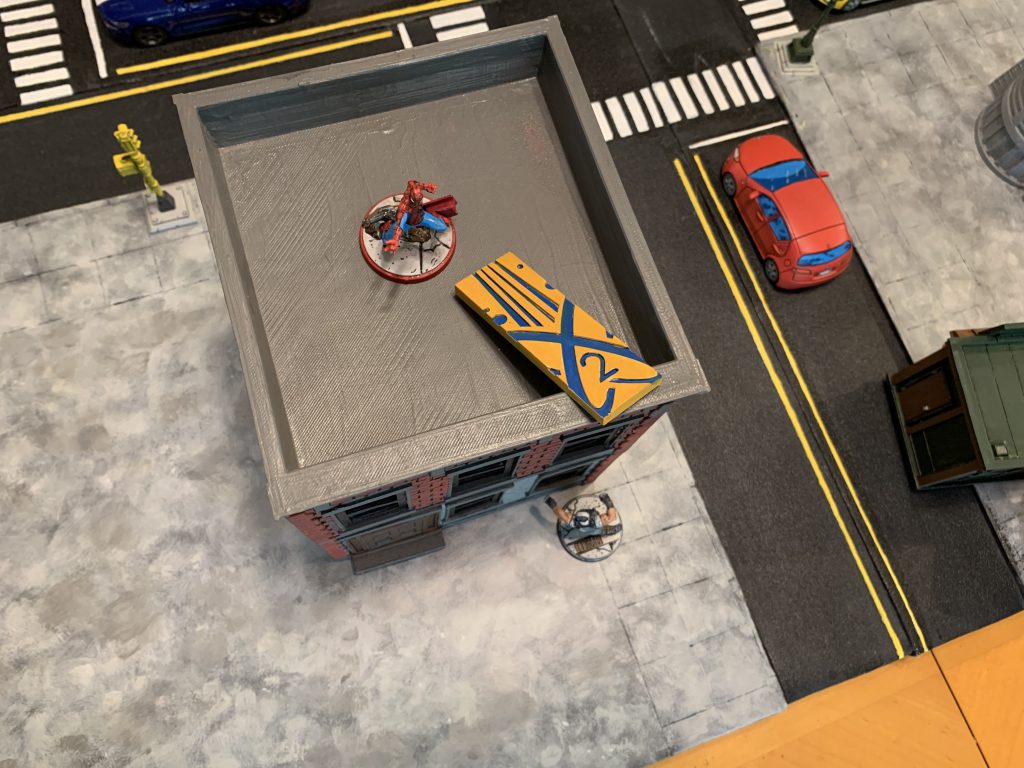
Partially Not Being Seen
Terrain is also used to provide cover, like in many other games. If any straight line between the attacker’s base and the target’s base crosses a piece of terrain and the target is within Range 1 of the terrain and the attacker is not within Range 2 of the target then the defender gets to change one defense die to a Block. Pretty helpful, you’re auto-cancelling one point of damage just by ducking behind a trash can. Cover is determined separately from LOS, and of course the attacker needs to have LOS to even make the attack (usually), but don’t conflate the rules. There’s nothing in the cover rules about the Size of the terrain vs the Size of the character. Hulk gets the same protection from being behind a lamppost that Ant-Man gets.
So in the example above even though Crossbones can punch Spider-Man from five storeys down, Spidey would get cover (since a line drawn between the two bases would cross the building) unless they are within Range 2 of each other (again, measured as if the board were 2D). Kind of wonky but once you adjust your brain to the principles behind it, it makes sense.
(If Crossbones and Spidey were on the same roof more than Range 2 apart Spidey would still get cover, even without anything actually between them. Because a line drawn between them still “crosses” a terrain piece – the roof itself. Of all these LOS and cover rules this one feels the weirdest, but it’s consistent.)
And there are other ways to gain cover, like from Storm’s Leadership ability, that may ignore some or all of the rules above. Those rules are only for determining whether terrain provides cover. So be sure to look at any character specific cover rules carefully.
What Should A Board Look Like?
When I’m setting up a board I like to divide it into quarters and make sure that each of the quarters has roughly the same amount and size of terrain so neither side has any kind of advantage. Not identical as that would be artificial and weird, but similar. One quarter may get one car (Size 2) and two shipping containers (Size 3), another may have the Bugle stand Size 3) and two dumpsters (Size 2). Then three or four Size 1 pieces (light poles, garbage cans) and a Size 4 (a bus or a large truck), and usually a size 5 building (only because I printed one and painted it up and I’ll be damned if I don’t use it).
The building is a large LOS blocker and you can knock characters into it all day long for the free point of damage. The Size 1 pieces may seem less useful, since throwing them only does two damage at most and they would almost never block LOS, but it’s still good to have them for providing cover and for knocking people into them.

You want to have enough terrain to make the game dynamic and interesting – and to not make those characters with throw powers feel sad. At the same time don’t make it feel so cluttered that characters without Flight or Wall Crawler can’t get around without running through a maze. Unless that’s the scenario you’re running, in the back alleyways of Hell’s Kitchen or some sadistic Arcade deathtrap. In MCP terrain is very much a “living” part of the game and is intended to be useful rather than hindering. So go out there, make up some themed terrain and send us pictures of Spider-Man your awesome boards!!
Have any questions or feedback? Drop us a comment below or email us at contact@goonhammer.com.

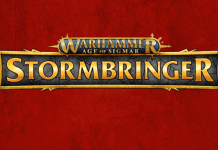
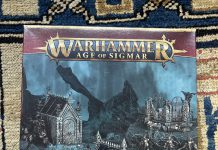
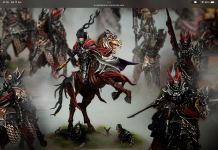
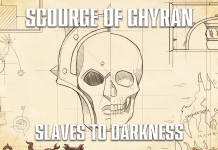
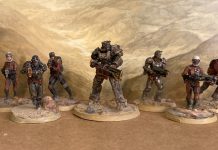
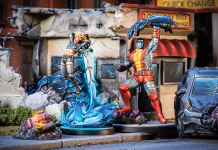


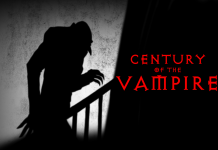
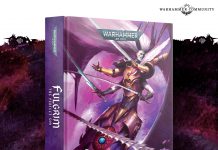
![[40k] Competitive Innovations in 10th: An Ominous Stench pt.2](https://d1w82usnq70pt2.cloudfront.net/wp-content/uploads/2020/01/Analysis_Banner.png)

